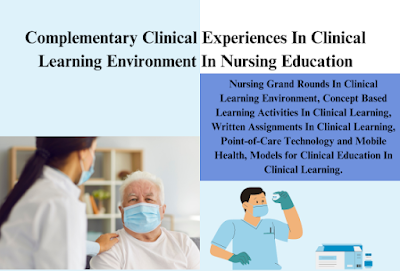The Complementary Clinical Experiences In Clinical Learning Environment In Nursing Education. However, if these expectations do not match their experiences, development can be hindered.
The Complementary Clinical Experiences In Clinical Learning Environment In Nursing Education
Nursing Grand Rounds are a dynamic teaching strategy that utilizes direct bedside experiences to enhance learning. These rounds involve demonstrations, patient interviews, or discussions of patient issues and nursing care. They offer valuable opportunities for idea exchange among clinical faculty, students, and staff.
Complementary clinical experiences in a clinical learning environment (CLE) for nursing students involve the integration of various methods alongside traditional clinical placements to enhance learning outcomes. These experiences aim to bridge the gap between theory and practice and provide students with diverse opportunities to develop their skills and confidence in a real-world setting. Clinical learning is an important component of nursing education and can support competency development. Nursing students have expectations prior to clinical learning.
Effective grand rounds require thorough planning. This includes obtaining patient consent, informing them about the rounds, and acknowledging their participation afterward. Debriefing sessions should follow, providing insights and planning for future rounds.
Concept-Based Learning Activities in Clinical Education
Concept-based learning activities are designed to deepen understanding and pattern recognition of specific health issues or diagnoses. For instance, students might explore fluid and electrolyte imbalances by conducting in-depth assessments of patients experiencing these issues. This method emphasizes the pathophysiology, treatment, pharmacology, and patient response to care.
Faculty facilitate comprehensive discussions, guiding students to recognize similarities and differences between cases, and identifying relevant findings and potential complications. This approach allows students to focus on critical thinking about concepts without the distraction of general patient care tasks.
Written Assignments in Clinical Learning
Written assignments complement clinical experiences by fostering critical thinking and clinical reasoning. These may include short papers, clinical reasoning papers, nursing care plans, clinical logs, journals, and concept maps. Research indicates that clinical logs, in particular, help students reflect on their experiences, communicate with instructors, and learn from mistakes and challenges.
Point-of-Care Technology and Mobile Health
The integration of point-of-care technologies and mobile health tools is increasingly essential in nursing practice. Faculty should ensure students become proficient with handheld devices, electronic health records, and relevant software. Simulated electronic health records in clinical simulations can prepare students for real-world use or serve as an alternative when agency policies restrict their access.
Smartphones with reference apps provide access to clinical information, care plans, evidence-based guidelines, skills videos, and patient education materials. Additionally, mobile health apps used for diagnosing, monitoring, and patient education are becoming prevalent and should be part of students’ learning experiences.
Models for Clinical Education
Several innovative models for clinical education are emerging to address faculty shortages and enhance student learning. These include:
- Preceptorship: Pairing students with experienced practitioners for hands-on guidance.
- Associate Model: Collaborating with clinical agencies to support learning and practice.
- Paired Model: Pairing students for shared clinical experiences.
- Academia-Service Partnerships: Collaborations between academic institutions and healthcare services.
- Adjunct Faculty Joint Appointments: Utilizing part-time faculty with clinical expertise.
These models aim to improve clinical placement capacity, competency development, and faculty-student ratios while fostering stronger ties with clinical agencies.
Conclusion
Incorporating Nursing Grand Rounds, concept-based learning activities, written assignments, point-of-care technology, and innovative clinical education models enrich the clinical learning environment. These complementary experiences enhance students’ critical thinking, clinical skills, and readiness for real-world practice, ultimately preparing them for effective and competent nursing careers.
Read More:
https://nurseseducator.com/didactic-and-dialectic-teaching-rationale-for-team-based-learning/
https://nurseseducator.com/high-fidelity-simulation-use-in-nursing-education/
First NCLEX Exam Center In Pakistan From Lahore (Mall of Lahore) to the Global Nursing
Categories of Journals: W, X, Y and Z Category Journal In Nursing Education
AI in Healthcare Content Creation: A Double-Edged Sword and Scary
Social Links:
https://www.facebook.com/nurseseducator/
https://www.instagram.com/nurseseducator/
https://www.pinterest.com/NursesEducator/
https://www.linkedin.com/in/nurseseducator/
https://www.researchgate.net/profile/Afza-Lal-Din
https://scholar.google.com/citations?hl=en&user=F0XY9vQAAAAJ

Incredible lots of fantastic facts.
casino en ligne francais
Superb tips, Thanks a lot.
casino en ligne francais
Wonderful information, With thanks.
casino en ligne francais
Reliable material, Thanks a lot.
casino en ligne
Regards, I value it.
casino en ligne
Wonderful info, Kudos!
casino en ligne
This is nicely expressed. .
meilleur casino en ligne
Thanks a lot! Valuable stuff.
casino en ligne
Terrific data, Appreciate it.
casino en ligne
Thanks! I value this.
casino en ligne France